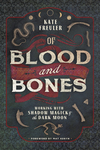An Interview with Kate Freuler
1. Your new book is Of Blood and Bones. What inspired you to write it?
This book actually began as series of thoughts in my personal journal. I was dealing with a very difficult time that was cycling through my life and this was reflected in my daily witchcraft practice. What I was experiencing and therefore doing in ritual was in stark contrast to what I saw on popular social media and in the spiritual wellness business. They were all touting the trendy message, "Stay positive! Be inspired! Gloss over all unpleasantness with a blast of white light and ignore it!" This toxic positivity didn't resonate in my real earthly life at all, and I was pretty sure I wasn't the only one. In fact, there's a real sense of guilt and shame for feeling "negative" or "dark" emotions in some witchy circles, encouraging people to ignore their shadow side or shut out their real feelings during life's difficulties. How unhealthy! So I decided to write a book about it.
2. Of Blood and Bones deals with a lot of dark energy and shadow work. Why is such work so important?
All of life is a constant cycle of light and dark, growth and rest, birth and death. While doing shadow work can be uncomfortable, it's just as much a part of our life, and our witchcraft practice, as the light parts. "Dark" energy isn't bad or negative; it's simply a necessary part of existence like night time or winter. If we neglect to do our shadow work, to face our inner selves and fully understand all of our motives and true feelings, our lives will become imbalanced. It's also important to understand that having "dark" feelings and dealing with them in ritual and spell work is okay, natural, and healthy. Shadow work is cathartic and can bring closure, strength, and peace.
3. Do readers need any previous knowledge to use the book?
This book can be read and implemented by a beginner witch, but it does help to have some very basic knowledge of witchcraft under your belt, such as circle casting, summoning energy in spells, and an understanding of the elements in magick. For more experienced readers, this book may shed light on some topics that have been labeled as taboo in their previous experience and therefore deepen their practice in a new way, or just challenge their current thinking.
4. Of Blood and Bones does deal with ritual work that uses ethically collected animal bones and blood, which is often a difficult topic. Why are these practices so often misunderstood?
I think both blood and bones immediately bring to mind the negative, misinformed connotations of witchcraft from times past such as the satanic panic or even the burning times. I think some practitioners sense that to discuss these practices openly is to invite criticism or even hate, awakening old prejudices. These items may also trigger an automatic and erroneous connection in peoples' minds between witchcraft and animal sacrifice, which is not practiced in this book (although it is examined and discussed).
I also think sometimes people, including within our own community, assume that any kind of bones and animal parts in ritual have come from a nefarious source, when in fact you can find many of these items in nature. Death is part of life, which is evident all around us. But in Western culture, we're often taught to fear and shun death, so bones and blood remind many people of their own uncomfortable relationship with mortality.
5. What do you hope readers take away from Of Blood and Bones?
I hope people will come away from the book with a tool for understanding their own difficult experiences, and a way to see how their own witchcraft practice can help them through it. I want them to learn that self-understanding is a source of strength. I also want readers to learn that there are many ways to practice witchcraft outside of what is most popular, that there is indeed a place in magick for processing negative emotions, practicing baneful magick and having a healthy relationship with death. I also hope to shed a more balanced light on the place of blood and bones in witchcraft, and to help people understand that there is no "right" and "wrong" in the craft when you're truly looking inside of yourself.

